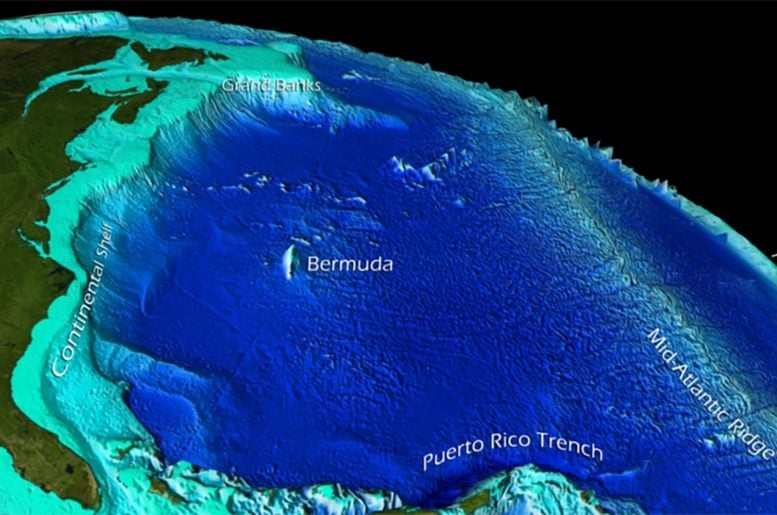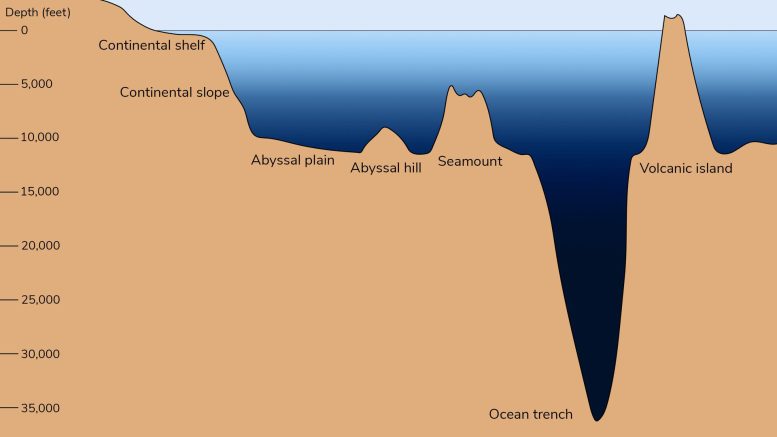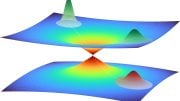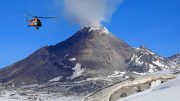
New research highlights the crucial role of ocean floor topography in oceanic carbon sequestration, explaining up to 50% of its variations over the last 80 million years and impacting climate change strategies and planetary studies. Graphic depicting satellite captured, bathymetric data of the western Atlantic Ocean basin and its ocean floor features. Credit: NOAA’s National Environmental Satellite and Information Service
Recent research reveals that up to 50% of the variations in carbon sequestration depths can be attributed to seafloor topography.
The carbon cycle, which involves the transfer of carbon among the atmosphere, oceans, and continents, plays a crucial role in controlling Earth’s climate. Various factors contribute to this cycle: volcanic eruptions and human activities release carbon dioxide into the atmosphere, while forests and oceans act as sinks, absorbing this CO2. Ideally, this system balances the emissions and absorption of CO2 to sustain a stable climate. Carbon sequestration is one strategy employed in the ongoing fight against climate change to enhance this balance.
A new study finds that the shape and depth of the ocean floor explain up to 50% of the changes in depth at which carbon has been sequestered in the ocean over the past 80 million years. Previously, these changes have been attributed to other causes. Scientists have long known that the ocean, the largest absorber of carbon on Earth, directly controls the amount of atmospheric carbon dioxide. But, until now, exactly how changes in seafloor topography over Earth’s history affect the ocean’s ability to sequester carbon was not well understood.
Research Findings and Methodology
“We were able to show, for the first time, that the shape and depth of the ocean floor play major roles in the long-term carbon cycle,” said Matthew Bogumil, the paper’s lead author and a UCLA doctoral student of earth, planetary and space sciences.
The long-term carbon cycle has a lot of moving parts, all functioning on different time scales. One of those parts is seafloor bathymetry — the mean depth and shape of the ocean floor. This is, in turn, controlled by the relative positions of the continent and the oceans, sea level, as well as the flow within Earth’s mantle. Carbon cycle models calibrated with paleoclimate datasets form the basis for scientists’ understanding of the global marine carbon cycle and how it responds to natural perturbations.

Graphic showing several ocean floor features on a scale from 0–35,000 feet below sea level. Credit: NOAA Office of Education
“Typically, carbon cycle models over Earth’s history consider seafloor bathymetry as either a fixed or a secondary factor,” said Tushar Mittal, the paper’s co-author and a professor of geosciences at Pennsylvania State University.
The new research, published in Proceedings of the National Academy of Sciences, reconstructed bathymetry over the last 80 million years and plugged the data into a computer model that measures marine carbon sequestration. The results showed that ocean alkalinity, calcite saturation state, and the carbonate compensation depth depended strongly on changes to shallow parts of the ocean floor (about 600 meters or less) and on how deeper marine regions (greater than 1,000 meters) are distributed. These three measures are critical to understanding how carbon is stored in the ocean floor.
Implications for Climate Change and Planetary Studies
The researchers also found that for the current geologic era, the Cenozoic, bathymetry alone accounted for 33%–50% of the observed variation in carbon sequestration and concluded that by ignoring bathymetric changes, researchers mistakenly attribute changes in carbon sequestration to other, less certain factors, such as atmospheric CO2, water column temperature, and silicates and carbonates washed into the ocean by rivers.
“Understanding important processes in the long-term carbon cycle can better inform scientists working on marine-based carbon dioxide removal technologies to combat climate change today,” Bogumil said. “By studying what nature has done in the past, we can learn more about the possible outcomes and practicality of marine sequestration to mitigate climate change.”
This new understanding that the shape and depth of ocean floors is perhaps the greatest influencer of carbon sequestration can also aid the search for habitable planets in our universe.
“When looking at faraway planets, we currently have a limited set of tools to give us a hint about their potential for habitability,” said co-author Carolina Lithgow-Bertelloni, a UCLA professor and department chair of earth, planetary and space sciences. “Now that we understand the important role bathymetry plays in the carbon cycle, we can directly connect the planet’s interior evolution to its surface environment when making inferences from JWST observations and understanding planetary habitability in general.”
The breakthrough represents only the beginning of the researchers’ work.
“Now that we know how important bathymetry is in general, we plan to use new simulations and models to better understand how differently shaped ocean floors will specifically affect the carbon cycle and how this has changed over Earth’s history, especially the early Earth, when most of the land was underwater,” Bogumil said.
Reference: “The effects of bathymetry on the long-term carbon cycle and CCD” by Matthew Bogumil, Tushar Mittal and Carolina Lithgow-Bertelloni, 15 May 2024, Proceedings of the National Academy of Sciences.
DOI: 10.1073/pnas.2400232121









“… volcanic eruptions and human activities release carbon dioxide into the atmosphere, while forests and oceans act as sinks, absorbing this CO2.”
A description that is both overly simplistic and wrong. The Carbon Cycle itself is poorly documented. An examination of the seasonal variations shows that the nearly constant anthropogenic sources, and the episodic volcanic eruptions, are a minor source of CO2. Instead, the seasonal, dominant ramp-up phase (Fall, Winter, Spring) is obviously driven by bacterial decomposition of detrital organic material and respiration from tree roots. The draw-down phase, which is shorter, happens from photosynthetic withdrawal of CO2 by terrestrial plants and marine plankton/algae. As a consequence of the more rapid, but shorter, photosynthetic withdrawal, there is an unbalance of about 2-3 PPMV every year, which is responsible for the annual increase. Additionally, calcifiers remove calcium bicarbonate to make their shells, and if the shells accumulate in relatively shallow water, they accumulate every year and make geologic features such as the White Cliffs of Dover. Similarly, calcium carbonate will precipitate in the tropics, notably in the Bahamas, when the water warms enough for the calcium carbonate to become saturated.
“This new understanding that the shape and depth of ocean floors is perhaps the greatest influencer of carbon sequestration …”
Something that is rarely mentioned is that the load created by the water column can affect the Long Carbon Cycle by isostatic adjustment. That is, the mantle (and its overlying crustal rocks) can, and does, flow slowly in response to the weight of the overlying water, deepening the basin(s). This is most clearly documented in the isostatic rebound of coastlines after the glaciers melted about 12,000 years ago.
” nearly constant anthropogenic sources”
What does this mean? There has been nothing constant about our use of hydrocarbon fuels nor for that matter in the human population since 1945. Both have increased exponentially and in lockstep, along with CO2 output.
I was talking about seasonal variations; however, I could have made that point clearer. While there has been a long-term increase in CO2, anthropogenic sources even now are only about 4% of the total annual flux of all sinks and sources. Unlike the natural sources, the anthro’ sources don’t show a notable seasonal variation. That is what I meant by ”nearly constant anthropogenic sources.” See particularly Figure 2 at https://wattsupwiththat.com/2022/03/22/anthropogenic-co2-and-the-expected-results-from-eliminating-it/
You might want to read what Wiki’ has to say about spurious correlations:
https://en.wikipedia.org/wiki/Spurious_relationship